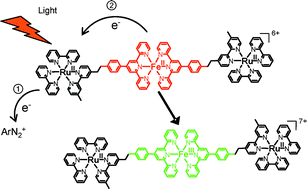A trinuclear [{RuII(bpy)2(bpy-terpy)}2FeII]6+ complex (I) in which a FeII-bis-terpyridine-like centre is covalently linked to two RuII-tris-bipyridine-like moieties by a bridging bipyridine-terpyridine ligand has been synthesised and characterised. Its electrochemical, photophysical and photochemical properties have been investigated in CH3CN and compared with those of mononuclear model complexes. The cyclic voltammetry of (I) exhibits, in the positive region, two successive reversible oxidation processes, corresponding to the FeIII/FeII and RuIII/RuII redox couples. These systems are clearly separated (ΔE1/2 = 160 mV), demonstrating the lack of an electronic connection between the two subunits. The two oxidized forms of the complex, [{RuII(bpy)2(bpy-terpy)}2FeIII]7+ and [{RuIII(bpy)2(terpy-bpy)}2FeIII]9+, obtained after two successive exhaustive electrolyses, are stable. (I) is poorly luminescent, indicating that the covalent linkage of the RuII-tris-bipyridine to the FeII-bis-terpyridine subunit leads to a strong quenching of the RuII* excited state by energy transfer to the FeII centre. Luminescence lifetime experiments show that the process occurs within 6 ns. The nature of the energy transfer process is discussed and an intramolecular energy exchange is proposed as a preferable deactivation pathway. Nevertheless this energy transfer can be efficiently quenched by an electron transfer process in the presence of a large excess of the 4-bromophenyl diazonium cation, playing the role of a sacrificial oxidant. Finally complete photoinduced oxidation of (I) has been performed by continuous photolysis experiments in the presence of a large excess of this sacrificial oxidant. The comparison with a mixture of the corresponding mononuclear model complexes has been made.

You have access to this article
 Please wait while we load your content...
Something went wrong. Try again?
Please wait while we load your content...
Something went wrong. Try again?


 Please wait while we load your content...
Please wait while we load your content...